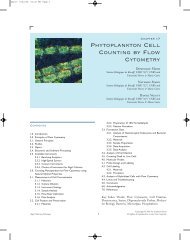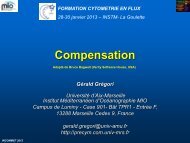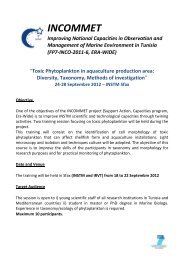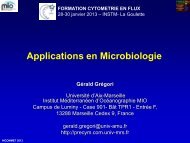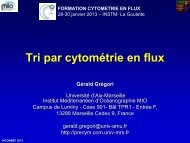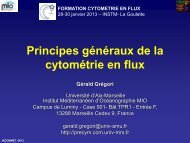Eukaryotic Picoplankton in Surface Oceans - incommet
Eukaryotic Picoplankton in Surface Oceans - incommet
Eukaryotic Picoplankton in Surface Oceans - incommet
Create successful ePaper yourself
Turn your PDF publications into a flip-book with our unique Google optimized e-Paper software.
Annu. Rev. Microbiol. 2011.65:91-110. Downloaded from www.annualreviews.org<br />
by CSIC - Consejo Superior de Investigaciones Cientificas on 09/27/11. For personal use only.<br />
a<br />
Cells ml –1<br />
c<br />
600<br />
500<br />
400<br />
300<br />
200<br />
100<br />
0<br />
Figure 5<br />
Atlantic Ocean<br />
Pacific Ocean<br />
Percentage of<br />
heterotrophic flagellates<br />
60<br />
50<br />
40<br />
30<br />
20<br />
10<br />
0<br />
Indian Ocean<br />
Mediterranean Sea<br />
D<br />
E<br />
C<br />
99<br />
b<br />
ENI40076.00355_AY937648<br />
Q2H12N10_EF172982<br />
NA11.4_AF363203<br />
104.1.11.12_GQ912992<br />
cRFM1.77_GQ344760<br />
G03N10_EF172970<br />
ME1.19_AF363188<br />
ME1.29_AY116223<br />
cRFM1.98_GQ344781<br />
A cRFM1.85_GQ344768<br />
cRFM1.27_GQ344711<br />
111.2.46_GQ913157<br />
cRFM1.95_GQ344778<br />
Biosope.T84.009_FJ537666<br />
IND31.95_DQ337353<br />
IND33.72_DQ337355<br />
cRFM1.17/32/44/100_GQ344702<br />
cRFM1.80_GQ344763<br />
81<br />
cRFM1.82_GQ344765<br />
cRFM1.99_GQ344782<br />
OLI11066_AJ402356<br />
TH01.6_EF539088<br />
UEPACCp4_AY129066<br />
BAFRACTpico.12_EU785311<br />
GW.r102.HET_GU219190<br />
BAFRACTpico.4_EU785304<br />
IND60.39/41_DQ234595<br />
He000803.3_AJ965033<br />
IND2.37_EU562170<br />
RFM3.24<br />
RFM1.38/73_GQ344685<br />
RFM3.08<br />
BL000921.16/22_AY381192<br />
Biosope.T17.014_FJ537446<br />
IND31.55/61_DQ337352<br />
IND58.11_DQ337356<br />
ENVP21819.00213_DQ918355<br />
GO.875.HET_GU218998<br />
IND58.12_DQ337357<br />
ENVP21819.00089_DQ918317<br />
SSRPD78_EF172962<br />
98 RFM1.48_GQ344665<br />
SSRPD72_EF172956<br />
IND31.115_DQ337354<br />
TH07.16_EF539107<br />
IND1.6_EU561666<br />
HD4bt0.21<br />
HD4bt0.62<br />
RA080215T.077_FJ431643<br />
RA010412.25_AY295590<br />
SCS099gi_DQ674794<br />
99 SIF.4E12_EF527083<br />
He001005.47_AJ965040<br />
BL000921.36_AY381199<br />
BL000921.9_AY381190<br />
HD4bt0.11<br />
RA001219.34_AY295547<br />
IND60.8_DQ234593<br />
RA010613.114_AY295674<br />
RA010412.23/146_AY295589<br />
RA000412.67_AY295414<br />
UEPAC05Cp2_AY129060<br />
05M82r.02_EU682544<br />
BL000921.40_AY381201<br />
TH01.2_EF539086<br />
108.1.14_GQ913034<br />
BL001221.8_AY381202<br />
MO010.150.00370_GQ383181<br />
IND60.13_DQ234594<br />
ME1.20_AF363189<br />
SSRPE01_EF172997<br />
ME1.30_AY116224<br />
0.02<br />
Abundance, phylogeny, and global distribution of the MAST-4 picoeukaryote. (a) Whisker plots of cell<br />
abundance (n = 20) and percentage of heterotrophic flagellates (n = 17) <strong>in</strong> mar<strong>in</strong>e sites worldwide. (b)<br />
Maximum likelihood phylogenetic tree show<strong>in</strong>g five ma<strong>in</strong> clades and their bootstrap values (A, dark blue; B,<br />
red; C,green; D,purple; E,light blue). (c) Clade affiliation of sequences from the Atlantic Ocean (n = 33),<br />
Indian Ocean (n = 22), Pacific Ocean (n = 25), and Mediterranean Sea (n = 39). Data from R.<br />
Rodríguez-Martínez (unpublished data) and Reference 56.<br />
B<br />
molecular surveys is that the global distribution<br />
does not translate to low diversity, because high<br />
OTU numbers are estimated from still undersaturated<br />
clone libraries.<br />
Determ<strong>in</strong><strong>in</strong>g the factors controll<strong>in</strong>g the<br />
abundance and ecological role of each species<br />
is the next critical issue, a titanic task given<br />
the large diversity seen. This can be done by<br />
104 Massana



